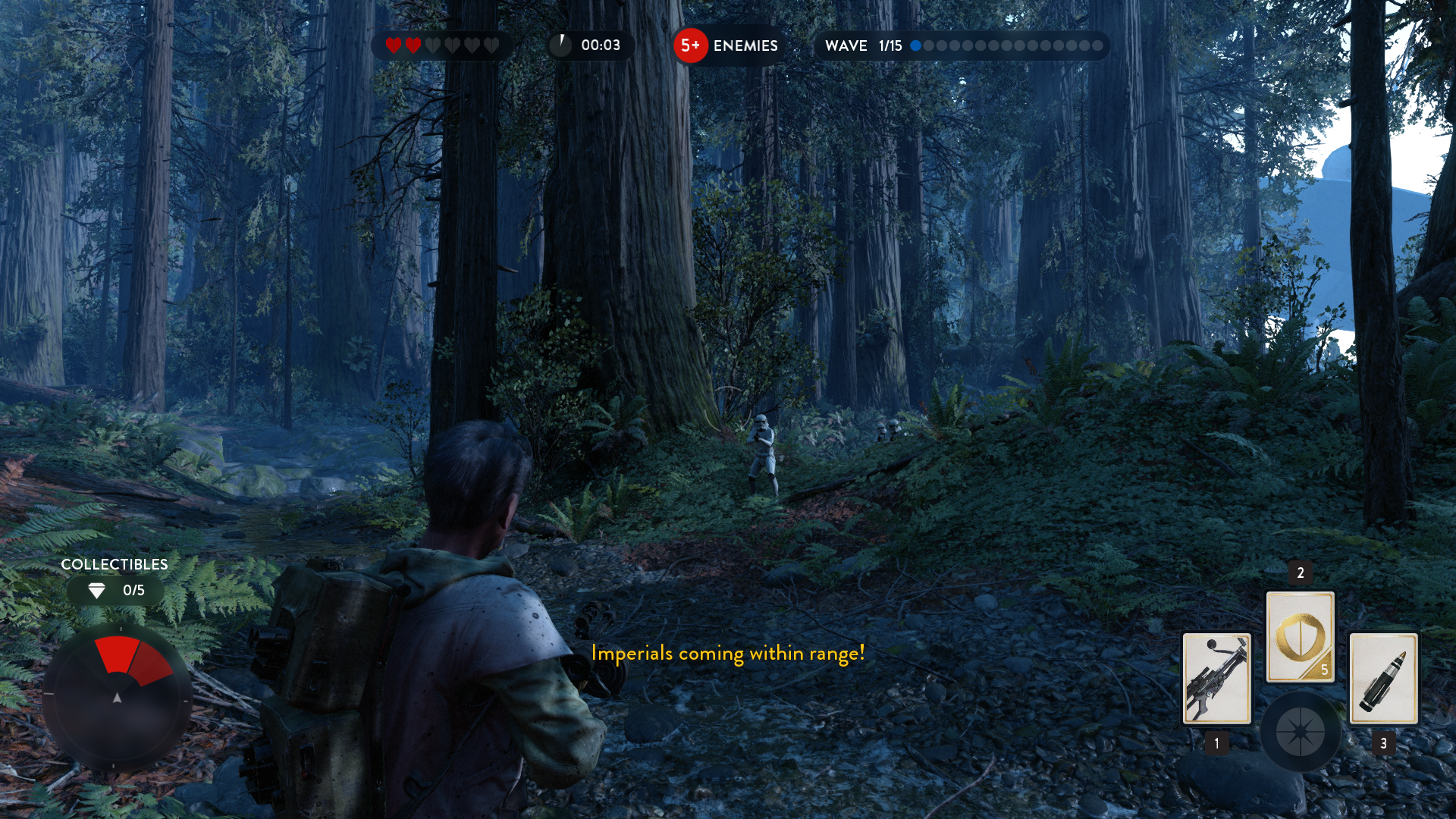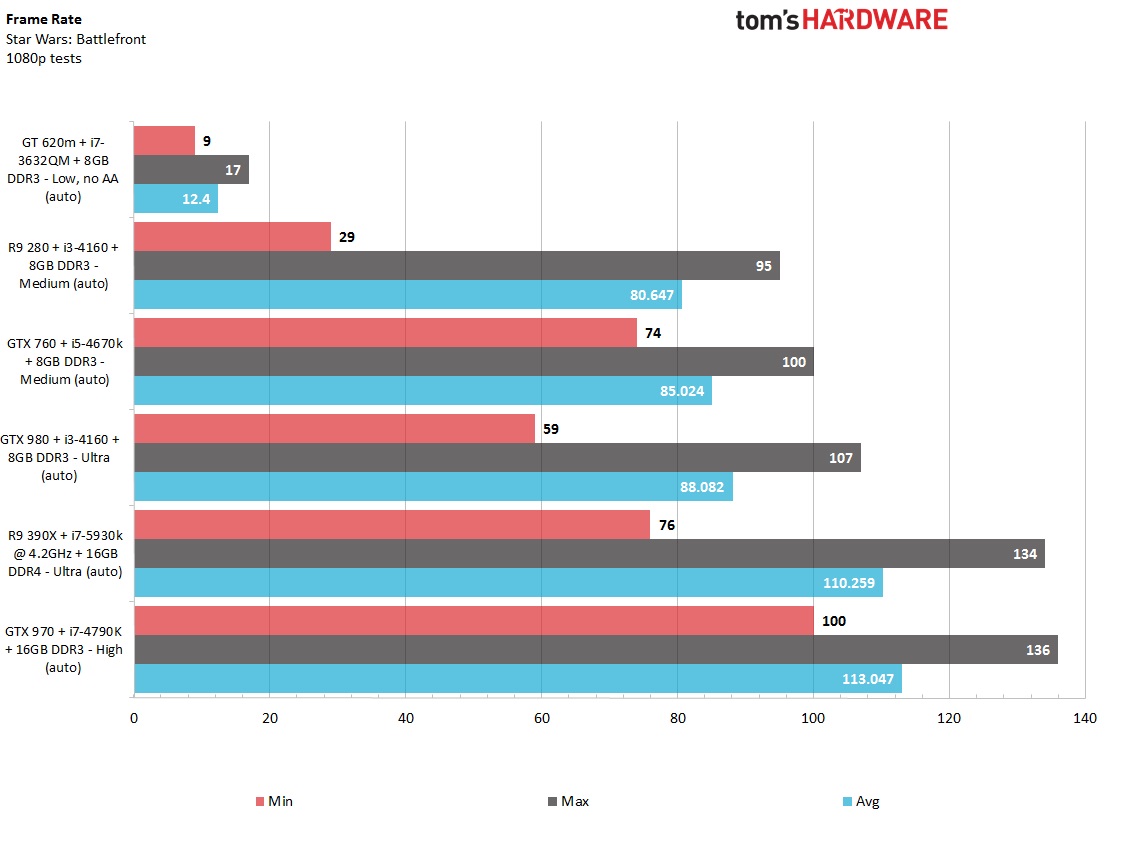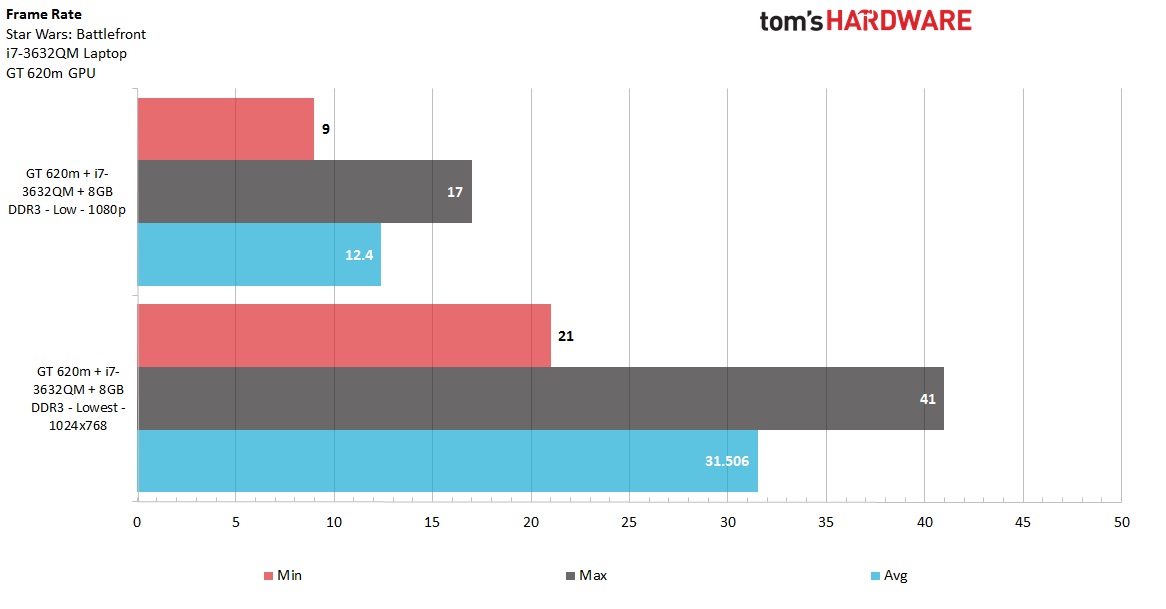'Star Wars Battlefront' Benchmarks: A Beautiful Galaxy Far, Far Away
Even though you have to use Origin instead of the more popular Steam platform to play Star Wars Battlefront, there are still a considerable number of people playing DICE's latest game on PC. Just like our tests with Fallout 4, we once again ran some benchmarks with some of the systems from several staffers of the Tom's Hardware news team. Before we get into the nitty gritty, just keep in mind that this is not a comprehensive test, but rather a sampling of how the game performs on builds of varying capabilities.
If you saw our Fallout 4 tests, you'll notice some similarities in the systems used. However, there are a few new entries, such as an Intel Core i5 build and a new GPU (specifically, Gigabyte's new GeForce GTX 980Ti Xtreme Gaming Windforce Edition. As an added test, we also played the game in 4K resolution.
| Reference System | Header Cell - Column 1 |
|---|---|
| CPU | Intel Core i7-5930k (4.2 GHz) |
| GPU | PowerColor Radeon R9 390X (8 GB) |
| RAM | Crucial 16 GB DDR4 (4x4 GB) |
| Storage | Crucial M200 SSD (500 GB) |
| Personal System #1 | Header Cell - Column 1 |
|---|---|
| CPU | Intel Core i7-4790K (4.4 GHz) |
| GPU | EVGA GeForce GTX 970 (4 GB) |
| RAM | Patriot Viper 3 DDR3 16 GB (2x8 GB) |
| Storage | Samsung 840 EVO SSD (500 GB) |
| Personal System #2 | Header Cell - Column 1 |
|---|---|
| CPU | Intel Core i5-4670K (3.4 GHz) |
| GPU | Gigabyte GeForce GTX 980Ti Xtreme Gaming Windforce Edition (6 GB) |
| RAM | Corsair Vengeance Pro 8 GB DDR3 (2x4 GB) |
| Storage | Seagate HDD (1 TB) |
| Personal System #3 | Header Cell - Column 1 |
|---|---|
| CPU | Intel Core i3-4160 (3.5 GHz) |
| GPU | Sapphire Radeon R9 280 (3 GB) |
| GPU 2 | EVGA GeForce GTX 980 (4 GB) |
| RAM | G.Skill Ares Series DDR3 8 GB (2x4 GB) |
| Storage | Western Digital Blue HDD (1 TB, 7200 RPM) |
| Laptop | Header Cell - Column 1 |
|---|---|
| CPU | Intel Core i7-3632QM (2.2 GHz) |
| GPU | Nvidia GeForce GT 620M (1 GB) |
| RAM | G.Skill Ripjaws 8 GB DDR3L (2x4 GB) |
| Storage | Seagate SSHD (1 TB) |
Testing Procedures
Just as before, we let the game auto-detect the hardware and change the graphics settings as it saw fit. The systems used to test at 4K were changed automatically to High or Ultra settings, whereas the benchmarks at 1080p varied from Medium to Ultra for the desktop builds. Based on its components, Star Wars Battlefront ran on the laptop at Low settings, and anti-aliasing turned off automatically. All the other builds had anti-aliasing on by default.
With Fallout 4 there was an issue regarding the forced implementation of VSync. This time around, there was a toggle to turn VSync on or off. On all automated settings, VSync was off by default.
The Results
At 1080p, all of the desktop builds performed smoothly, with the lowest frame rate average at 80.647 fps. The lowest score was turned in by an Intel Core i3-4160 with a Sapphire Radeon R9 280 (a little less than $200 when I bought it earlier this year), AKA my first build and on a budget.
Although the amount of content may be scarce in terms of excitement and overall Battlefront nostalgia, DICE was still able to make these alien planets of Tatooine, Endor and Hoth look beautiful. If it looks good at 1080p, there's no doubt it will be a breathtaking sight at 4K. None of the cards tested at the higher resolution reached a 60 fps average. In fact, the highest average score was with Gigabyte's massively overclocked 980Ti variant at 54.424 fps. The PowerColor Radeon R9 390X finished second at 42.812 fps, and the EVGA GeForce GTX 970 was third (and last) with 38.294 fps.
Michael Justin Allen Sexton's budget gaming laptop was once again thrown into the gauntlet, and surprisingly, its best score was an average of 31.506 fps, but that came at a price. Not only were the graphics options set to Lowest, but the resolution was brought down to a mere 1024x768. The game is still playable at this configuration, but it's hard to appreciate the scenery at that resolution. What's even worse is at 1080p, the game's fps count didn't even register in the 20s, with an average of just 12.4 fps.
Get Tom's Hardware's best news and in-depth reviews, straight to your inbox.
With Flying Colors
It's no surprise that the higher-end desktops posted high scores, but the fact remains that you don't need the extra power to still enjoy the game. An Intel Core i3 CPU and a mid-tier graphics card can do the trick, especially if you're on a tight budget. For those who have more money to spend, seeing the Star Wars universe in 4K is an exciting opportunity (either way, it's best to check out our story on the "Best Graphics Cards For The Money").
The game, however, is not worth the $60 price tag at launch, but it could be worth the money when the price goes down and more downloadable content is released in the future.
______________________________________________________________________
Rexly Peñaflorida II is a Contributor at Tom’s Hardware. He writes news on tech and hardware, but mostly focuses on gaming news. As a Chicagoan, he believes that deep dish pizza is real pizza and ketchup should never be on hot dogs. Ever. Also, Portillo’s is amazing.
Follow Rexly Peñaflorida II @Heirdeux. Follow us on Facebook, Google+, RSS, Twitter and YouTube.
Rexly Peñaflorida is a freelance writer for Tom's Hardware covering topics such as computer hardware, video games, and general technology news.
-
salgado18 Honestly? I think that not having AMD CPUs on a game benchmark is a serious omission.Reply
Fallout 4 suffered from the same thing, and even the AMD official twitch channel used an Intel CPU. It was very strange, so I dug up, and found that AMD CPUs suffer a lot in it, and especially the 9590, which had lots of stuttering.
How can we know that doesn't happen in SWB? -
MasterMace Forces you into the massive privacy violation that is OriginReply
Recycles Battlefield ui
Severely limited map selection
Yup smells of EA all over it -
AdviserKulikov Any game benchmark that doesn't include AMD FX processors is worthless to almost half of the gaming community. AMD GPUs are pretty solid, but their CPU performance often leaves games running very slowly.Reply -
burkhartmj Reply16975598 said:Any game benchmark that doesn't include AMD FX processors is worthless to almost half of the gaming community. AMD GPUs are pretty solid, but their CPU performance often leaves games running very slowly.
AMD makes up less than 20% of the CPU market share. It's like saying benchmarks are useless if they don't include OSX or Linux. Sure, for some people that may be true, and I feel for you, but the vast majority are served just fine by Wintel testing platforms. -
clonazepam Buying Battlefront (for $110 for the full experience) reminds me a lot of buying a singer's Christmas album.Reply
Seems like it'd wear out fast and collect a lot of dust. It's also EA, so there's that going against it as well.
My nephew played the beta on his iMac and loved it, so kudos to development. -
firefoxx04 Amd might have 20% of the total market share but what about the gaming community market share? There are no statistics for that.. And I don't trust steams.Reply -
Quixit Reply16975598 said:Any game benchmark that doesn't include AMD FX processors is worthless to almost half of the gaming community. AMD GPUs are pretty solid, but their CPU performance often leaves games running very slowly.
AMD makes up less than 20% of the CPU market share. It's like saying benchmarks are useless if they don't include OSX or Linux. Sure, for some people that may be true, and I feel for you, but the vast majority are served just fine by Wintel testing platforms.
Apple is only about 7.5% of the worldwide PC market so... you're not exactly comparing Apples to Apples here. ;) -
Kenneth Barker You guys really really need to get better quality writers and reviewers on this site. It is sort of embarrassing really...Reply
The first graph shows the systems (with mixed specs from the ones listed above. Show me again where the system with the 980 and the i3-4160 and 8 GB of RAM is again. There isn't one, but its listed that way in the graph. The first graph is also running the game at different settings! You have low, medium, high, and ultra settings all crammed into the same graph. With the "highest" performer being the 970 and 4790K system, but its only running on High, and "second place" being run on ultra. You guys are amateurs.
Seriously, you are terrible at what you do. -
Kenneth Barker I now see where the 980 system was tucked away in a GPU2 mention. The layout and description is still way off. Not sure why it wasn't listed as a completely separate system. Considering it was changed from an AMD card to an NVIDIA card and needed to make significant changes to the system via drivers, not sure why it was lumped together as a single system. It is certainly not. Also not too sure why the 980 was stuffed into the i3 system.Reply




